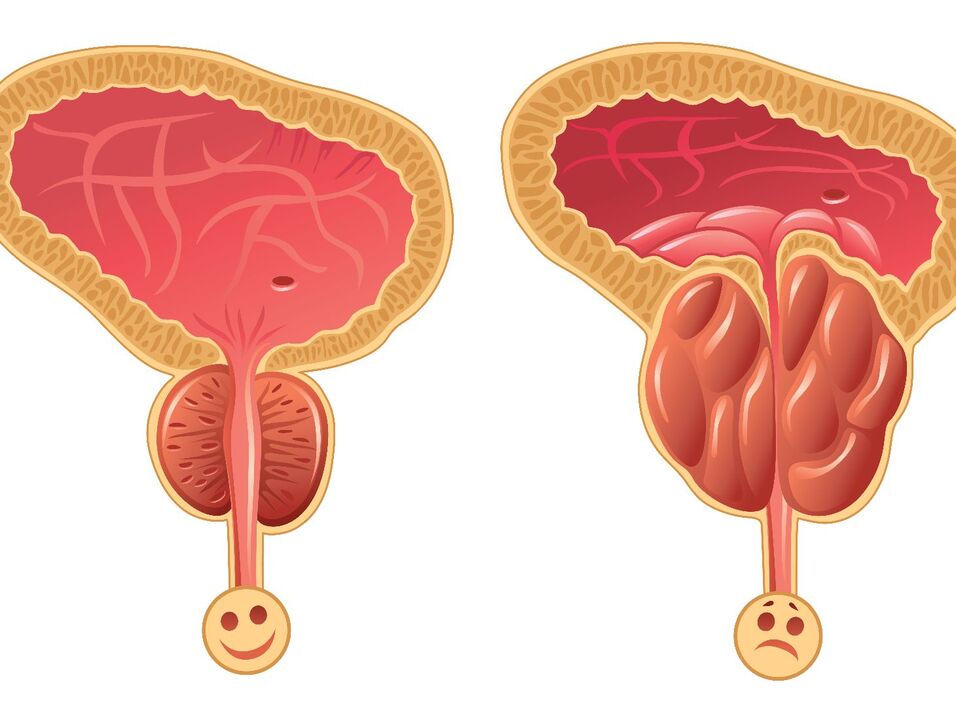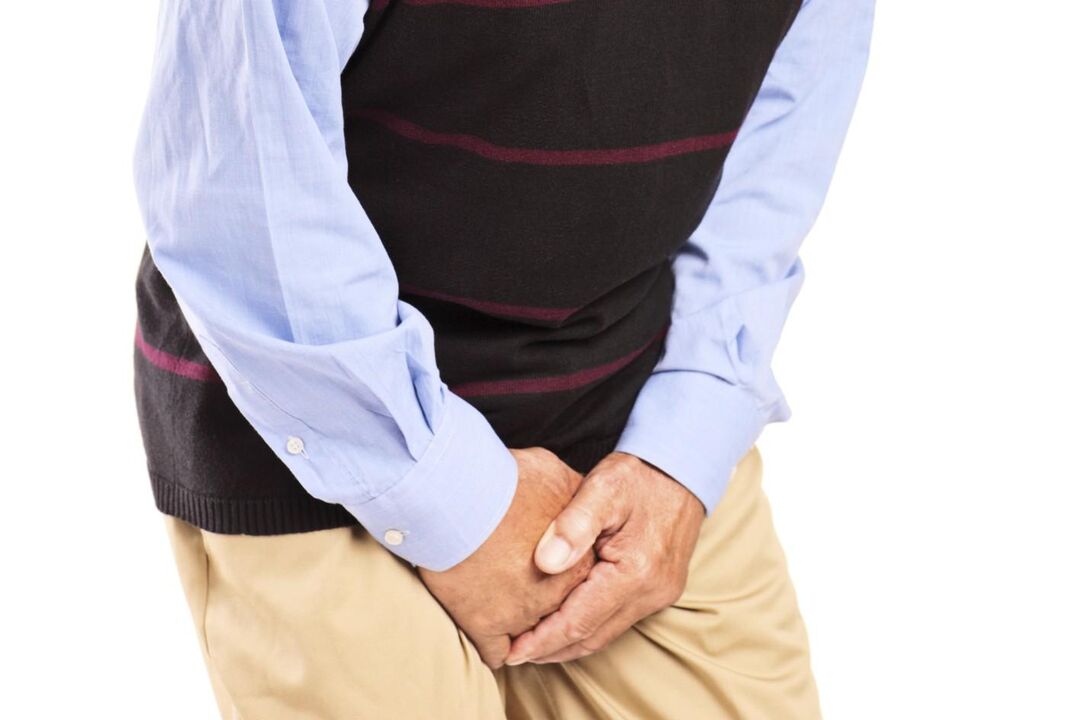If the inflammatory process in the prostate is due to obstruction, the disease is called congestive, congestive, or noninfectious prostatitis. Prostatitis develops because the blood-filled lobules are not completely emptied. Most often, congestive prostatitis in men occurs due to irregular sexual life, which occurs in older patients. However, there are cases where the disease occurs due to chronic prostatitis and some other provoking factors.
Causes of congestive prostatitis

The main and main cause of pathology is disruption of normal blood circulation in the pelvic organs. But prostate stagnation occurs due to factors such as:
- Acute and/or chronic diseases of an infectious nature. Infection enters the prostate through the urethra, rectum, or lymphatic vessels;
- Hormonal imbalance in the patient's body;
- Increased sexual activity leads to sexual exhaustion;
- The practice of interrupting intercourse;
- Arousal does not reach the level of ejaculation;
- Prolonged sexual intercourse with prolonged and "blocked" ejaculation;
- Insufficient emptying of the prostate;
- A sedentary lifestyle leads to poor circulation in the pelvic organs;
- Varicose veins of the pelvic organs;
- Trauma or damage to the pelvic organs.
Elements can be combined and supplemented by individual reasons. It is possible to find out the provoking factor of urological diseases only by undergoing a complete examination by a specialist.
By type, congestive prostatitis is divided as follows:
- Vein.Similar stagnation in men occurs if there are pathological changes in the venous system. For example, varicose veins of the lower extremities: the veins dilate, blood accumulates in the pelvic organ system, leading to its transfer to the prostate and causing the development of pathology.
- Jam.The form of the disease is characterized by incomplete emptying of the gland, which leads to an increase in the inflammatory process - more common in adult men.
- Cognitive prostatitis– a disease with hidden symptoms, dangerous due to many complications. Stagnation leads to irreversible consequences for the glandular organ - shedding of layers of epithelial tissue.
- Chronic congestive prostatitis.It appears due to irregular sex life, frequent masturbation, sedentary lifestyle and other factors. The main symptom is semen coming out in clumps. The prostate gland increases in volume, which is dangerous due to the possibility of developing more complex diseases.
- Infectious.It develops due to infection through the genitourinary system during the course of congestive pathology, which intensifies the inflammatory process and worsens the patient's general condition.
Important!Only a specialist can determine the type and form of pathology. Self-treatment of congestive prostatitis without consulting a doctor is dangerous and is possible only in the early stages of the disease..
Symptoms of congestive prostatitis

In the early stages of prostatic stagnation, symptoms are difficult to detect and faint. This is what complicates the timely diagnosis of the problem. But there are still some pathological signs:
- aching feeling in the groin, replaced by a burning, aching feeling after walking or standing for a long time;
- pain spreading to the sacrum and inner thighs;
- decreased sexual desire;
- feeling of incomplete emptying of the prostate – incomplete orgasm;
- poor erection;
- pain when urinating;
- the act of urinating at night is characterized by a dilute or intermittent stream of urine;
- sharp pain in the groin, spreading to the anal area;
- General health decline: weakness, fatigue, forgetfulness.
The development of pathology from acute to chronic form leads to an increase in pain syndromes - unpleasant sensations become stable. The pain becomes more frequent and localized in the groin. However, acute relapses were replaced by remissions and the patient believed he was cured, and congestive prostatitis had turned chronic, dangerous due to inflammation of the excretory ducts and sloughing off. epithelial tissues.
Important!The most dangerous symptom is stopping urination. If the patient has similar phenomena, you should immediately consult a doctor, regardless of whether the syndrome is aggravated by pain symptoms or other signs of prostatic stagnation..
Diagnosis of congestive prostatitis

The nonspecific nature of the disease makes diagnosis difficult. In order not to be mistaken with the conclusion, the urologist conducts several examinations:
- Palpation and rectal examination to evaluate prostate condition and rectal hemorrhoids;
- Blood and urine tests;
- Analyze prostate secretions to determine resistance to drug groups;
- Supersonic;
- In exceptional cases, a CT scan and examination of the genitourinary system are prescribed - this allows us to clarify the cause of the disease.
Only after the diagnosis is made, treatment for congestive prostatitis is indicated. It should be remembered that the disease can be successfully eliminated at any stage, but full sexual function can be preserved with early treatment.
Treatment of congestive prostatitis
To choose an effective treatment option for blockage in the prostate, an examination is performed and an individual treatment course is prescribed. Today, medicine has a lot of possibilities to cure diseases: medication, physiotherapy, surgery, as well as folk methods to eliminate this problem, without exception, help all diseases. cause, but only a specialist can tell you how to treat congestive prostatitis.
Medicines
Drug treatment is prescribed using antibacterial agents, alpha blockers, muscle relaxants, hormonal drugs, and cell therapy. Antibacterial drugs are indicated for the treatment of congestive prostatitis caused by infection, but they should be taken with a group of drugs to maintain immunity. The choice of medication is influenced by the causative bacteria.
Alpha blockers are drugs that open the sphincter, blocking the effects of impulses that affect the muscle tone of smooth muscle. Taking medication helps improve the patient's condition, increase the frequency of urination, reduce the sensitivity of spasms and pressure on the bladder wall.
Herbal medicine is a specially selected herbal complex used only as a complement to other treatments. Herbal medicine is effective in reducing inflammation, has antibacterial effects, and helps disperse congestion in the prostate.
Hormone drug therapy is used to normalize the balance of estrogen and androgen. Therapy reduces inflammation and prevents further development of pathology.
Muscle relaxants are a special group of drugs that act on the striated muscles located in the perineum. Reduced muscle tone leads to pain relief, helps relieve tension in the pelvic diaphragm and eliminates feelings of fullness and pressure.
Important!Drug treatment is prescribed only by a specialist. Self-medication is prohibited. Herbal medicines are also contraindicated in patients without a definite diagnosis. In the early stages of congestive prostatitis, choosing the wrong complex will be ineffective, and in later stages it will worsen the patient's condition..
Physiotherapy and its role in effective treatment

A large number of physiotherapy methods acting on the patient's body allows you to choose the most effective treatment, often without the use of heavy drugs. The role of physiotherapy in eliminating diseases is huge:
- Normalizes blood circulation in the pelvic organs;
- Eliminate negative symptoms;
- Restores normal function of the prostate;
- Increase male sexual ability;
- Prevent clogging.
Physical therapy methods include:
- Prostate massage.One of the effective ways to treat congestive prostatitis. By improving blood circulation, massage helps to completely eliminate congestion, improve muscle tone and diaphragm, enhance the effect of drugs and normalize the function of the prostatic duct. Contraindications: incomplete bladder emptying, internal cancer, cysts, stone formation in the prostate.
- Exercises aim to strengthen and relax the pelvic floor musclesis an "at home" treatment option for ideal results. A special set of exercises is very simple to perform, such as: squeezing and relaxing the anal muscles, but at the same time it is so effective that it allows you to completely get rid of congestive prostatitis and neverencounter further pathological threats.
- Neuromodulation therapy (neuromodulation)is an electric current treatment aimed at eliminating pain syndrome. It is done in many ways, the most common of which is stimulating the nerve endings of the spinal cord. Dermal exposure produces good results, however, treatment has contraindications and is prescribed on an individual basis.
- Acupuncture massage or acupuncture- a good and effective method involves the insertion of special needles into strictly defined points on the body. Goal: activate recovery processes and normalize blood flow, speed up recovery. But there is a great danger of falling into the hands of a bad specialist and instead of treating it, making the problem worse.
Laser treatment of prostate obstruction is very well proven. The impact on the nerve endings of cells ensures quick elimination of the main problem and accompanying negative symptoms.
Important!Physical therapy, like other treatments, is prescribed by a specialist. Seeking help without a definitive diagnosis is dangerous.
Surgical method

Surgical treatment of stagnation is the last resort used in cases where other methods of eliminating the pathology have not worked. Indications for intervention are:
- narrowing of the urinary tract;
- prostate abscess;
- sclerosis of the prostate;
- BPH;
- violation of the flow of secretions through the seminal vesicles.
There are several surgical techniques, the choice of which depends on the clinical picture of the pathology and the individual characteristics of the patient.
Ethnographic
Alternative healing options are welcomed by urologists, but only as a supplement to traditional healing methods. The advantage of home treatment is that it increases the effectiveness of medication, relieves pain and normalizes blood flow.
How to treat prostate blockage:
- Propolis tincture is sold in pharmacies or prepared independently from 100 grams. raw ingredients (natural) and 1 liter of pure vodka. Mix well, leave in a cool, dark place for 14 days (occasionally shake the box), drink drop by drop: 7-10 drops, 4 times a day before meals. Drugs based on propolis give positive effects as quickly as possible and are especially good for chronic congestive prostatitis in elderly patients.
- Regular pumpkin seeds will help cure early forms of the disease. 100 grams. Grind the refined ingredients in a mortar to a paste, mix with 1 tbsp. I. It's so delicious, take 1 teaspoon. on an empty stomach in the morning until the symptoms of the disease are completely eliminated and as a preventive measure.
The simplest and most affordable option to get rid of congestive prostatitis is to eat green vegetables and a decoction of parsley. This herb is rightfully considered "masculine" and helps not only relieve all negative symptoms, but also normalizes blood circulation in the pelvic organs. You can and should eat fresh greens every day as well as brew 100 grams. herbs 1 l. Boil water, leave for 15-20 minutes and drink as tea during the day.
Congestive prostatitis is a treatable disease, but men must understand that treatment should begin as soon as possible. There are many factors that cause pathology, so stasis can occur in any patient.































